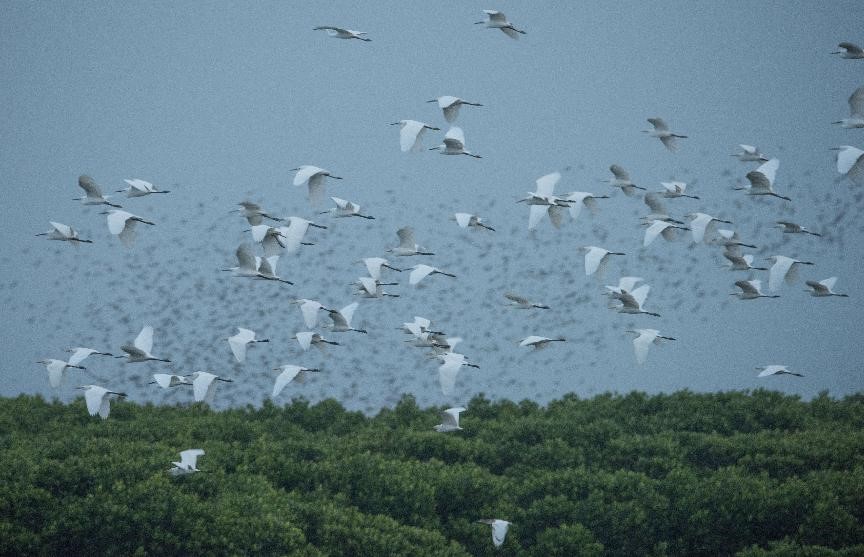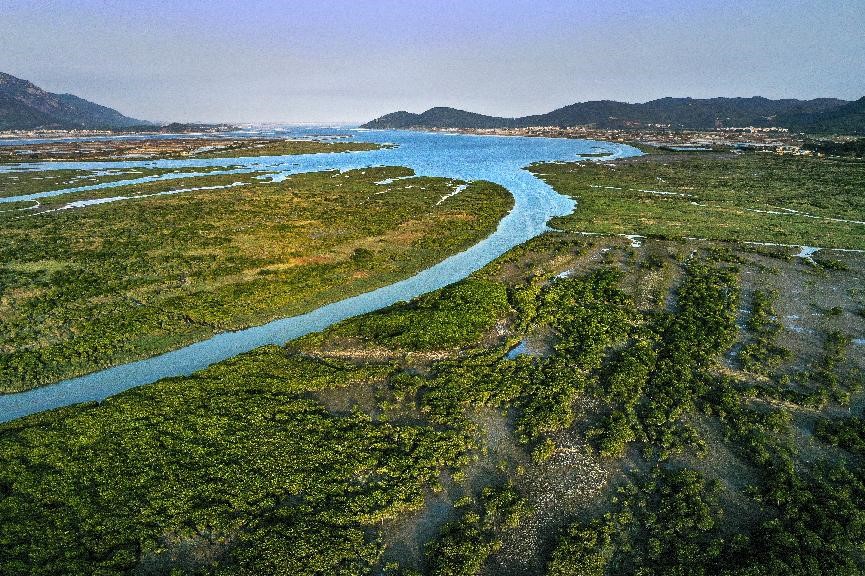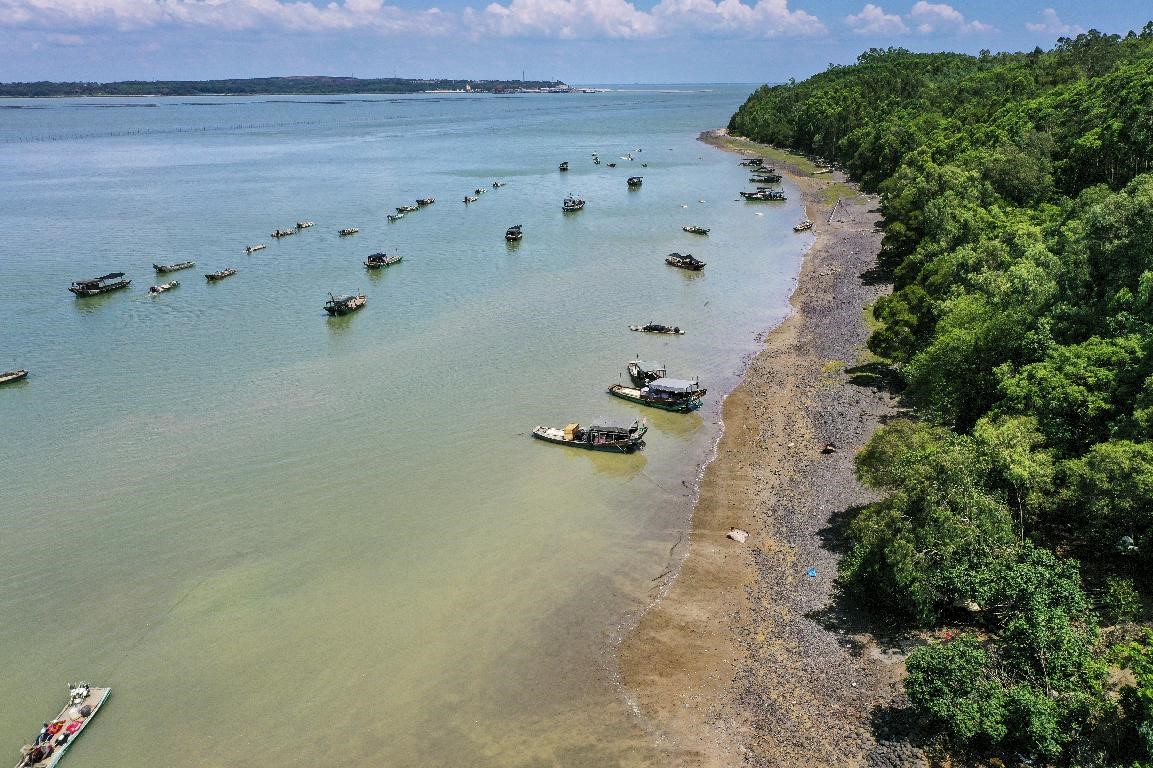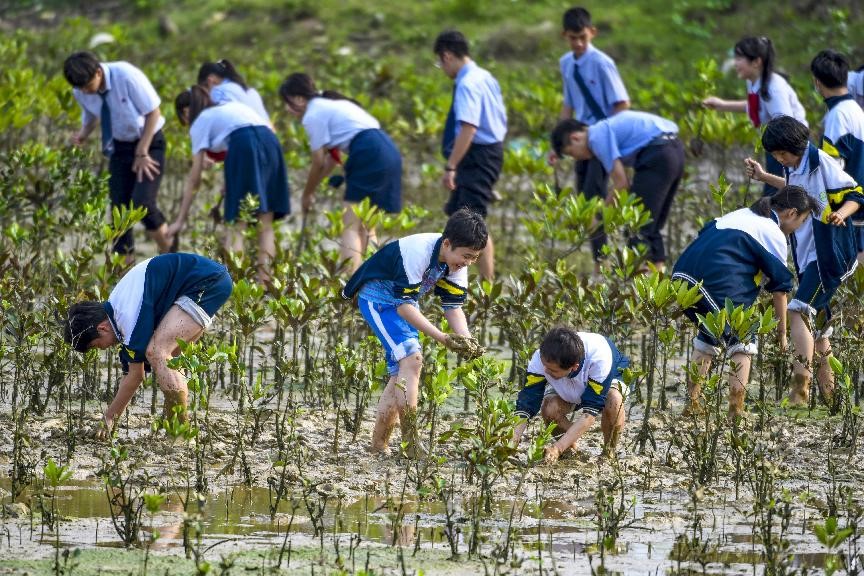China achieves notable results in mangrove forest protection and restoration
Rare Chinese egrets have been once again seen at Dongzhaigang National Nature Reserve in south China’s Hainan province since the local mangrove forests were revitalized, said residents living near the nature reserve.

A flock of birds fly over a mangrove forest in Dongzhaigang National Nature Reserve in south China’s Hainan province, Jan. 30, 2021. (People’s Daily Online/Meng Zhongde)
Located in Yanfeng township, Meilan district, Haikou city, capital of Hainan province, Dongzhaigang National Nature Reserve is the first of its kind in China that focuses on mangrove forest protection.
With continuous efforts and progress being made in the protection and restoration of local mangrove forests, the species and populations of wildlife in the nature reserve have been expanding. The number of bird species recorded in the nature reserve has increased from about 180 to more than 200.
As one of the marine ecosystems with the richest biodiversity in coastal zones of tropical and subtropical regions, mangrove forest plays an irreplaceable role in maintaining the ecological security of coastal zones.
China’s mangrove forests are mainly distributed in areas including Zhejiang, Fujian, Guangdong, Hainan provinces,and Guangxi Zhuang autonomous region.
The country regards strengthening mangrove forest protection and restoration as a vital part of its efforts to build marine ecological civilization and protect and restore the ecology of its territorial space.

Photo shows Zhangjiangkou national mangrove forest nature reserve in Yunxiao county, Zhangzhou city, southeast China’s Fujian province. (People’s Daily Online/Zhao Min)
In recent years, by establishing nature reserves and taking a series of measures, including strengthening regulation and control over the use of woodland, returning aquaculture ponds to forests, maintaining mangrove trees, cultivating seedlings, carrying out patrols and inspections, and ensuring the fulfillment of responsibilities, China has steadily pushed forward with mangrove forest protection and restoration and made remarkable achievements in this regard, becoming one of the few countries in the world with a net increase in the mangrove area.
China’s third national land survey shows that the country now has 406,000 mu (about 27,067 hectares) of mangrove forests.
China plans to build and restore 18,800 hectares of mangrove forests by 2025, said an action plan jointly issued by the country’s Ministry of Natural Resources and National Forestry and Grassland Administration last year.
According to the action plan for mangrove forest protection and restoration from 2020 to 2025, local governments and departments in China are required to give priority to the protection of mangrove forests, draw ecological protection red lines for mangrove forests and areas suitable for the growth of mangroves, and ensure strict protection for relevant areas.
Meanwhile, according to the natural law of ecological succession, efforts should be made to restore mangrove forests, said the action plan.
Zhanjiang Mangrove National Nature Reserve in Zhanjiang city, Guangdong province, the largest mangrove nature reserve in China, has made breakthroughs in exploring paths to realizing the value of ecological products.
On June 8, 2021, the management bureau of Zhanjiang Mangrove National Nature Reserve, the Third Institute of Oceanography under China’s Ministry of Natural Resources, and Beijing Entrepreneur Environmental Protection Foundation signed an agreement on the transfer of carbon emissions allowance regarding 5,880 tons of carbon emissions, marking the completion of China’s first blue carbon trading project.

Photo shows the Shankou Mangrove Nature Reserve in Shankou township, Hepu county, south China’s Guangxi Zhuang autonomous region. (People’s Daily Online/Zhao Min)
Beijing Entrepreneur Environmental Protection Foundation purchased the allowance to offset the carbon emissions caused by its activities. The profits from the project have been used for the management and protection of mangrove forests, the involvement of communities in the protection of mangroves, as well as other efforts to ensure continuous maintenance of the results in the ecological restoration of mangrove forests.
The project has given full play to the role of a market-based trading mechanism and realized the goal of seeking ecological, social, and economic benefits of mangrove resources.
Mangrove forests in Guangdong Zhuhai Qi’ao-Dangan Island Provincial Level Nature Reserve in Xiangzhou district, Zhuhai city of Guangdong province, attract a steady stream of visitors every year.
Residents have changed their way of utilizing mangroves as tourism resources, from beachcombing, digging seashells, and other practices that are harmful to natural resources to ecological education and edutainment.
The transformation can not only avoid the destruction of mangrove resources, but extend tourism season, improve tourists’ experience, and increase local people’s income from tourism.

Nearly 100 middle school students and volunteers take part in a wetland protection-themed educational activity at an area of a project launched to return aquaculture ponds to forests in Yanfeng township, Meilan district, Haikou city, capital of south China’s Hainan province, planting trees for the local mangrove wetland, March 11, 2021. (People’s Daily Online/Wang Chenglong)
Many regions in China are exploring the possibility of combining ecological remediation and culture and the proliferation of fishery resources.
By turning abandoned shrimp culture ponds into the mangrove forest, making good use of the natural productivity and baits to proliferate understory economic organisms, and implementing sustainable exploitation of resources, people can realize continuous improvement in ecosystems and continuous production of economic organisms, said Zhao Peng, associate professor at Hainan University.
According to experts, People can turn ecological advantages into economic advantages and reap economic benefits from mangrove forests as long as they can well protect and restore mangroves and bring into full play their ecosystem functions.
Photos
Related Stories
Copyright © 2021 People's Daily Online. All Rights Reserved.










